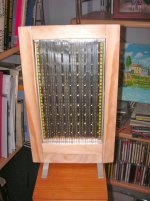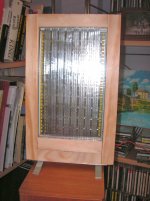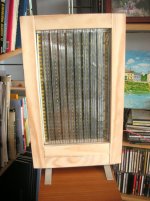Looks super cool.
A questions (which you might already have answered):
How did you cut the alu ... one long flatwire, which was afterwards attached/glued ... and if so how did you cut it up ..
Best regards Baldin
yes, there is a brief explanation at #34 http://www.diyaudio.com/forums/plan...planar-magnetic-using-neos-4.html#post2873611
should you need furter explanations, just ask
more pics
more pics that refused to upload before:
close-up's of the babies.
the yellow stuff behind the metal sheet is a cloth to damp the membrane movement. A kind of Spontex borrowed from the kitchen
more pics that refused to upload before:
close-up's of the babies.
the yellow stuff behind the metal sheet is a cloth to damp the membrane movement. A kind of Spontex borrowed from the kitchen
Attachments
If post #67 is a good infication of the freq response (the left one), then your high mids are 10 -15 db higher than low and high end ...
This will indeed sound clear and tiring ...
1. make a new freq measurement again. One where the speaker is mounted on top of your Tannoy, mic 1 meter from and at same height.
2. Make same measurement with the speaker on the desk top.
(post here)
If the high mids are still very high, you have to correct with a filter, or use a graphic eq e.g. when playing via MediaPlayer ...
This will indeed sound clear and tiring ...
1. make a new freq measurement again. One where the speaker is mounted on top of your Tannoy, mic 1 meter from and at same height.
2. Make same measurement with the speaker on the desk top.
(post here)
If the high mids are still very high, you have to correct with a filter, or use a graphic eq e.g. when playing via MediaPlayer ...
I wouldn't jump to any conclusions about the need for filtering or equalization until a redeisgn is considered, or at least until the data is corrected for the source, amp, and mic.
Very high membrane tension was mentioned. Something about overheating versus frequency was mentioned. There was confusion about what the driving power was, versus frequency. That all needs to be sorted out, first. Perhaps the actual power being converted to sound is too low (at some frequencies, at least) and the membrane tension was raised to some ridiculously-high level to try to get enough SPL, and maybe that created some exaggeration of the mechanical resonances.
Secondly, did you compare the frequency response to that of the amp alone (using an equivalent resistive load)? The mic and amp without the speaker? If not, we have nothing to base any decisions on.
You need to test with a different power amplifier, at the least, which should be one that can routinely drive 1 or 2 Ohm speakers, at every frequency, at high power levels, without any problems.
But I would take another look at the conductors on the membrane. Is the total resistance too low for your amp? The foil could be made much narrower, to raise the resistance in proportion to the width reduction. Do you know how the temperature of the foil will vary with current, for different foil widths? I would find out. Perhaps with a proper total resistance, your amplifier could produce lower frequencies with much more SPL, even with a much lower membrane tension. Perhaps with a lower membrane tension the response might flatten out.
Or perhaps you should make the frame slightly non-rectangular (one long side longer than the other, for example), so that the resonances won't all be in one or two narrow frequency bands. Otherwise, you could try clamping the membrane at one or two points, to see if it flattens the response (like Magnepan's "tuning dots").
But even if you can bring down the main peak (even assuming it's not an artifact of your amplifier), you would still then need more total SPL. So you could consider making sure that the total resistance is at least 4 Ohms. Before that, just to check if that could be the problem, you could try testing it with an amp that can drive 1 or 2 Ohms at high power without any problem.
Very high membrane tension was mentioned. Something about overheating versus frequency was mentioned. There was confusion about what the driving power was, versus frequency. That all needs to be sorted out, first. Perhaps the actual power being converted to sound is too low (at some frequencies, at least) and the membrane tension was raised to some ridiculously-high level to try to get enough SPL, and maybe that created some exaggeration of the mechanical resonances.
Secondly, did you compare the frequency response to that of the amp alone (using an equivalent resistive load)? The mic and amp without the speaker? If not, we have nothing to base any decisions on.
You need to test with a different power amplifier, at the least, which should be one that can routinely drive 1 or 2 Ohm speakers, at every frequency, at high power levels, without any problems.
But I would take another look at the conductors on the membrane. Is the total resistance too low for your amp? The foil could be made much narrower, to raise the resistance in proportion to the width reduction. Do you know how the temperature of the foil will vary with current, for different foil widths? I would find out. Perhaps with a proper total resistance, your amplifier could produce lower frequencies with much more SPL, even with a much lower membrane tension. Perhaps with a lower membrane tension the response might flatten out.
Or perhaps you should make the frame slightly non-rectangular (one long side longer than the other, for example), so that the resonances won't all be in one or two narrow frequency bands. Otherwise, you could try clamping the membrane at one or two points, to see if it flattens the response (like Magnepan's "tuning dots").
But even if you can bring down the main peak (even assuming it's not an artifact of your amplifier), you would still then need more total SPL. So you could consider making sure that the total resistance is at least 4 Ohms. Before that, just to check if that could be the problem, you could try testing it with an amp that can drive 1 or 2 Ohms at high power without any problem.
- Status
- This old topic is closed. If you want to reopen this topic, contact a moderator using the "Report Post" button.


